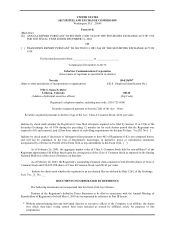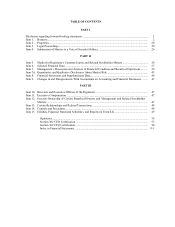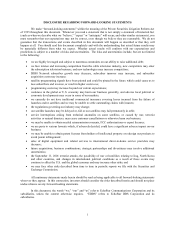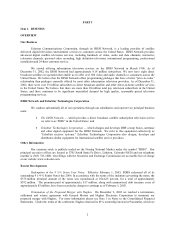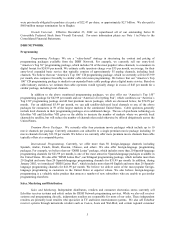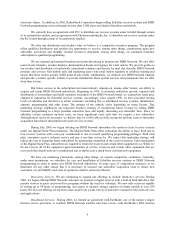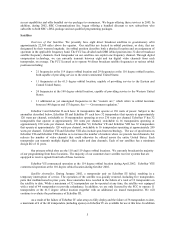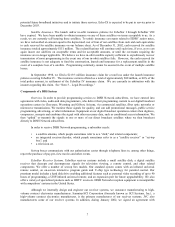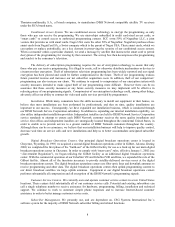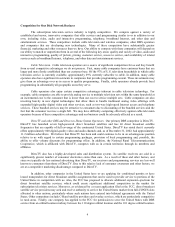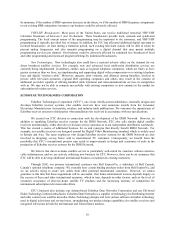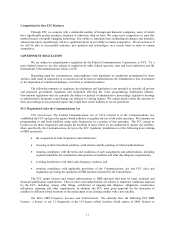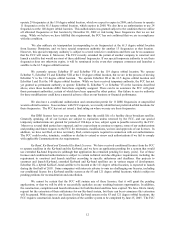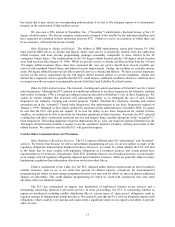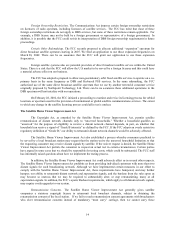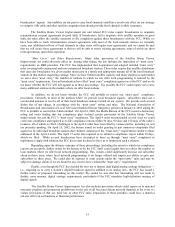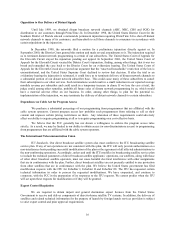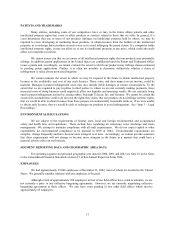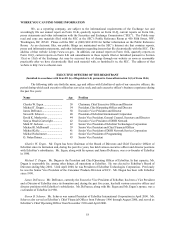Dish Network 2002 Annual Report Download - page 10
Download and view the complete annual report
Please find page 10 of the 2002 Dish Network annual report below. You can navigate through the pages in the report by either clicking on the pages listed below, or by using the keyword search tool below to find specific information within the annual report.8
Thomson multimedia, S.A., a French company, to manufacture DISH Network compatible satellite TV receivers
under the RCA brand name.
Conditional Access System. We use conditional access technology to encrypt the programming so only
those who pay can receive the programming. We use microchips embedded in credit card-sized access cards, or
“smart cards” to control access to authorized programming content. ECC owns 50% of NagraStar LLC, a joint
venture that provides us with smart cards. Nagra USA owns the other 50% of NagraStar. NagraStar purchases these
smart cards from NagraCard SA, a Swiss company which is the parent of Nagra USA. These smart cards, which we
can update or replace periodically, are a key element in preserving the security of our conditional access system.
When a consumer orders a particular channel, we send a message by satellite that instructs the smart card to permit
decryption of the programming for viewing by that consumer. The set-top box then decompresses the programming
and sends it to the consumer’s television.
The delivery of subscription programming requires the use of encryption technology to assure that only
those who pay can receive programming. It is illegal to create, sell or otherwise distribute mechanisms or devices to
circumvent that encryption. Theft of subscription television programming has been widely reported and our signal
encryption has been pirated and could be further compromised in the future. Theft of our programming reduces
future potential revenue and increases our net subscriber acquisition costs. In addition, theft of our competitors’
programming can also increase our churn. We continue to respond to compromises of our encryption system with
security measures intended to make signal theft of our programming more difficult. However there can be no
assurance that these security measures or any future security measures we may implement will be effective in
reducing piracy of our programming signals. Compromises of our encryption technology could, among other things,
adversely affect our ability to contract for video and audio services provided by programmers.
Installation. While many consumers have the skills necessary to install our equipment in their homes, we
believe that most installations are best performed by professionals, and that on time, quality installations are
important to our success. Consequently, we have expanded our installation business, which is conducted through
our DISH Network Service Corporation subsidiary. In addition to expanding our internal installation capability, we
also utilize independent installation providers. Independent installers are held to DISH Network Service Corporation
service standards to attempt to ensure each DISH Network customer receives the same quality installation and
service. Our offices and independent installers are strategically located throughout the continental United States, in
order to enable us to provide service to a greater number of DISH Network customers throughout the country.
Although there can be no assurance, we believe that our installation business will help to improve quality control,
decrease wait time on service calls and new installations and help us to better accommodate anticipated subscriber
growth.
Digital Broadcast Operations Centers. Our principal digital broadcast operations center is located in
Cheyenne, Wyoming. In 1999, we acquired a second digital broadcast operations center in Gilbert, Arizona. During
2000, we completed the first phase of the “build-out” of the Gilbert facility for use as a back up for our main digital
broadcast operations center in Cheyenne. In order to comply with “must-carry” rules, effective January 1, 2002 (see
“-Government Regulation”), we began utilizing the Gilbert facility as an additional digital broadcast operations
center. With the commercial operation of our EchoStar VII and EchoStar VIII satellites, we expanded the role of the
Gilbert facility. Almost all of the functions necessary to provide satellite-delivered services occur at the digital
broadcast operations centers. The digital broadcast operations centers use fiber optic lines and downlink antennas to
receive programming and other data. The digital broadcast operations centers then uplink programming content to
our direct broadcast satellites via large uplink antennas. Equipment at our digital broadcast operations centers
performs substantially all compression and all encryption of the DISH Network’s programming signals.
Customer Service Centers. We currently own and operate customer service centers in seven United States
locations. These centers field substantially all of our customer service calls. Potential and existing subscribers can
call a single telephone number to receive assistance for hardware, programming, billing, installation and technical
support. We continue to work to automate simple phone responses and to increase Internet-based customer
assistance in order to better manage customer service costs.
Subscriber Management. We presently use, and are dependent on, CSG Systems International Inc.’s
software system for the majority of DISH Network subscriber billing and related functions.

